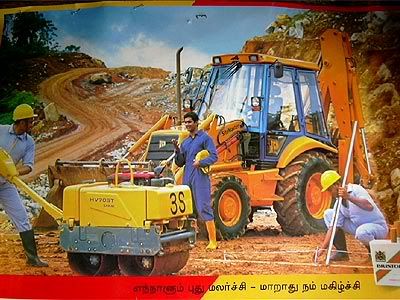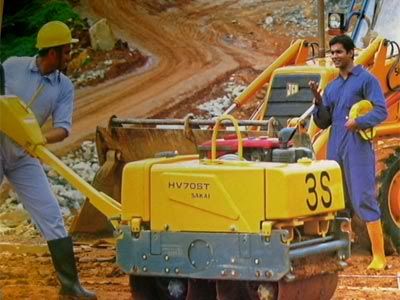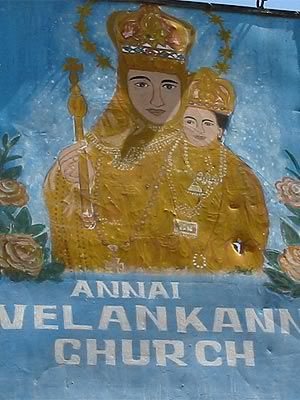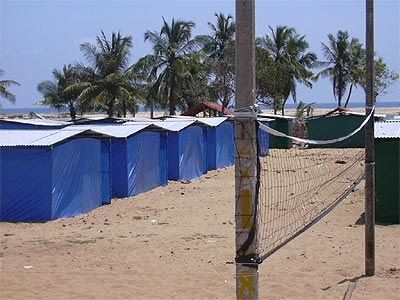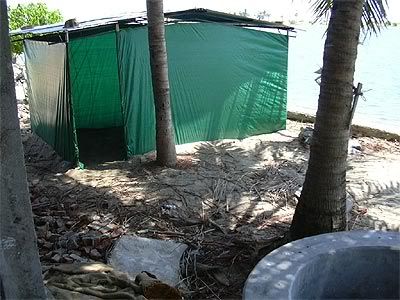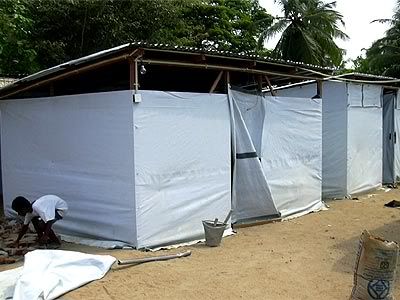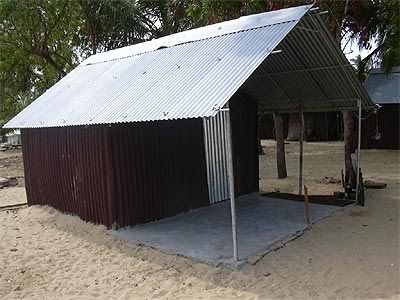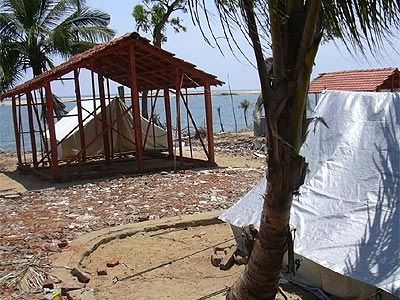
So I did... for the Easter weekend. Yep, decided that while you guys were involved in all things eggy and chocolaty, I'd rent a motorbike and head down south for a few days to Aragum Bay. Yep, Davy boy on a motorbike! Watch out Sri Lanka! (Unfortunately, photo-wise you'll have to be waiting for the pictures - apart from the one above of me looking very cool on my super bike - as I was not able to borrow a digital camera for the trip. Anyway, use your imagination... ;o)
My reasons for heading down were two-fold:
1) I wanted to check out the areas south of Kallar, how badly they were affected, and how the relief work was progressing. It can get very insular living in this small village, and my knowledge of what's been happening outside of the immediate area has strictly been second hand.
2) I needed a bit of R'n'R. I've been in Sri Lanka now for almost two months, and in all honesty it's seemed a lot longer, oh yeah! And with a few frustrations getting to me a bit, I thought the break would do me good. Plus, it had been a while since I'd had a good ol' night out on the town!
Anyway, Friday morning and I'm all packed, hop onto my Suzuki super bike, all 250cc of her, and damn if that old classic tune doesn't come into my head... "Get your motor running.... Head out on the highway..."
Well, not sure about "highway", the best you can ever hope for in Sri Lanka is "paved road" though not sure if that would rhyme?? Anyway, after working out how to start the thing, I felt an old familiar feeling between my legs... so I rushed off to the bathroom before I left. Boom boom!
Okay, enough of the bad jokes I hear you say...
So anyway, I'm underway, "out on the highway", "looking for adventure", or at least "looking at" the dirty great bus bearing down on me in the middle of the road (as all good Sri Lankan bus drivers must drive, scattering those before them)...
Actually, speaking of Sri Lankan buses, I never knew that in Sri Lanka "bus" meant "mobile disco", did you? I mean, it must do, what with the bright throbbing fluro lights that any good Sri Lankan bus driver worth his salt has plastered around the inside cabin of his bus and often along the isles, pulsing to the beat of his extremely loud Sri Lankan pop music, which is a cross between Britney Spears on speed and the sound of nails scratching down a blackboard. And just like any good disco, this even happens if you board a bus at 5:00am in the morning after an excruciating long overnight train trip from Colombo. Party on Sri Lanka!
Anyway, back to my adventure at hand... and I'm actually feeling pretty good, cruising along, breeze blowing in my face, keeping me probably as cool as I've been since leaving Colombo and its air-conditioned restaurants and shopping centres. I'm finding it just slightly harder than usual to wave to every second kid I pass, shouting out the obligatory "Hello, how are you, what's your name?" as I ride by them, but that's probably a little understandable. I mean, up until yesterday afternoon I had never ridden a motorbike before, and I figured for a newbie I was doing okay, but I definitely wasn't going to take one of my hands of the handle bar and wave at the kids!
After a couple of hours riding, and a bit of a sore arse from the not so comfortable seat (just couldn't quite get comfortable wrapping my legs around a throbbing piece of machinery), I decided to turn off the main road and head towards the coast, just to check out the damage and work being done in this area.
So headed up along this narrow street, walled houses either side of me as is the style in Sri Lanka, bumping across the odd pot hole or two in the hard packed dirt road... then saw that I was approaching a group of people - men mostly - hanging out under a tree, not doing much else it seemed apart from staring at me by this time. As I slowly bumped past them, I saw to my left in a small clearing amongst houses an IDP (Internally Displaced Persons) camp, small tin roofed shacks with some Islamic relief organisation logo on them. I continued past the group, and came upon the affected area, starting about 70 metres or so from the ocean here - so a little closer than in Kallar, where the tsunami caused damage up to 200 and sometimes 300 metres from the coast. However, unlike Kallar, where there were many trees remaining and people have mostly moved back to their land, even if they're living in tents, shelters or the remains of their partly damaged houses, here there was no sign of life or habitation within this almost completely flattened and treeless strip of land.
Upon reaching a road running along the beach I pulled up and switched the engine off. The first thing I noticed was the silence, again a little different from Kallar at this time of day (early afternoon) when you would hear at least some sign of life. I could hear the waves breaking gently on the beach, along with a few birds here and there, but from what seemed to have been a fairly populated area judging by the density of the housing leading up to the affected area, the complete lack of life in this area near the beach was quite eerie. I guess if comparing to the Kallar area, the housing here did go right up to the beach, where as in Kallar there was always a strip of sandy land around 100m wide between the nearest houses and the ocean, plus at one end of Kallar village there is also a narrow lagoon separating the village from the beachfront and ocean. However, just as in Kallar, there was still a couple of houses only partly damaged standing right at the beachfront.
After my brief moment of contemplation, a small group of people - actually, one guy and a couple of kids on bicycles - arrived from the small group I'd passed. The usual "Hello... How are you? ...What's your name?" from the kids, and then the guy introduced himself, and offered to show me where he lived. This happened to be back at the IDP camp, or to be more accurate as I was to discover, at another small camp set behind this first one.
I parked my bike near the group of men under the tree, and followed the guy towards his "home". My first sight of the shelters was of a long corrugated tin roof and long dark tarp wall, a "terrace house" type construction with each family living side by side sharing walls. Women cooking over a small fire out the front of their tiny shelter, small kids playing in the dirt... Ah yes, the dirt... If I remember nothing else from this country, it will be the dirt. Dirt ground, dirt floors everywhere. Even in the "nice" houses, dirt is just constantly tracked in to form this omnipresent covering over every floor. And in the camp, the dirt ground outside flows unbroken into the dirt floor inside the shelter.
The guy showed me the inside of his "home", and it was as sparse as you would imagine, a few reed mats for sleeping rolled up in the corner, clothes hanging from wire hung along the wall. He explained to me as best he could in his very broken English (which is substantially better than my minimal Tamil) that they were not getting much in the way of help from the government or the local NGO, now that they had their shelters. It seemed that the move into the next phase - permanent housing - was a long way off for these folks. I gave my promise to him to try to do as much as I could for them (though what that may be I don't know at the moment), and then headed back to the main road.
Another couple of hours of the normal Sri Lankan urban scenery - mostly fairly rundown retail businesses along the main road, the odd school, factory, featureless government building, mosque and church - and then finally hit some open country side: flat, featureless plains with various low lying crops growing. Soon after, the road finally began to run along the coast - it runs a kilometre or so inland for most of its journey down the east coast - and I passed a cemetery that had been shown no mercy by the tsunami. Headstones all over the place, some of the smaller ones had obviously been tossed around by the force of the waves, the larger ones tilted this way and that with great swathes of land washed out from under them. I shuddered to think of what else had been washed out of the ground and by now hopefully removed or reburied.
Shortly after this, I arrived in a place that was even more eerie... From a fairly bleak, rough and ready road and surroundings, I suddenly found myself cruising along this relatively smooth, wide road amongst huge, overhanging trees. It was like a large boulevard or similar. Amongst the trees, usually set back from the road a bit - and this was probably the most striking difference with the Sri Lanka I had so far experienced, where everything is built right up to the road edge - were houses, and a couple of temples and stores. It was a small, and quite lovely, seaside village... however it appeared to be absolutely empty. I slowly cruised to a standstill, and switched the engine off. The only sound was the ocean just off to my left. I looked around for any sign of life, even a dog. There was some obvious damage here and there - actually quite substantial in a couple of places - however certainly not enough that you wouldn't expect people to still be living there. But no... no sound, no sign of anyone or anything moving. It reminded me of some horror movie, where you've awoken in a village and all the people have disappeared... So as they say, I got on my bike and rode!
I rode over a bridge out of the village, and finally saw my first person for a while. That made it seem even stranger that no one was living there, if just up the road and over a bridge people were living. A strange experience indeed.
Further on I rode through an area of bush, and then quite suddenly came across the start of a substantial tent IDP camp, stretching into the trees on both side of the road. This must have gone on for about a kilometre, and though quite depressing in a way to see so many still living in tents, at least the trees offered shade and protection from the wind. I was to see a lot bleaker up the road.
I passed a tent camp of the Finnish Red Cross, obviously the NGO for the area. At least these guys were actually living in tents rather than some of the more salubrious hotels that some other NGOs had taken up residence in other parts of the country. Their location near the IDP camp, and the delivery of building materials within the camp as I passed, seemed to indicate that as far as circumstances allowed, the needs of the people here were being addressed. I know it may seem impossible that anyone could make a judgement of that kind while simply riding through a place, but it was certainly the impression I got drawing on my limited experiences. As I said earlier, my two months here has seemed FAR longer, and I feel like I have experienced and learnt far more during this period than at any other time in my life.
...continued







